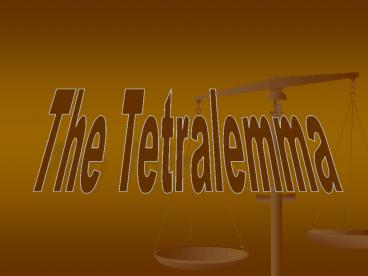The Tetralemma PowerPoint PPT Presentation
Title: The Tetralemma
1
The Tetralemma
2
The Tetralemma as Yes!, No!, Both Yes and
No!, and Neither Yes nor No!, can in a
practical, and human fuzzy sense, be found in
Latin American history, from the time of the
conquest.
3
- Conformity And An Enthusiastic Embrace Yes!
4
- The New World as the end of the world made it the
opportune landing for the New Jerusalems descent
from the sky. Meditating on the conquered
Tenochtitlán, Motolinía wrote, You were once
Babylon, full of confusion and evil now you are
another Jerusalem, the mother of provinces and
kingdoms. Elaboration of the Amerindians as
descendants of the lost tribes of Israel
reinforced the link between the New World and the
New Jerusalem, notably in the ponderings of
Agustín de Betancur at the end of the 17th
century. Following a tally of twelve religious
families in Mexico, Betancur mixed metaphors to
celebrate his noble city as a new Jerusalem with
twelve gates through which to enter the Jerusalem
of triumph. The twelve tribes of Israel are
twelve precious stones that shine like stars
in the crown of the woman of Apocalypse. With
such noble encouragement, the Amerindians were
baptized in droves.
5
- Liberation theologists continue this tradition
into the present when they unambiguously assert
that Europe is no longer the center of Christian
history. Latin America is. The recuperated
New World was romanticized as a promised land in
a flurry of benedictions from José Martís Our
America (and its extension into the Cuban
Revolution) to José Vasconceloss explicit
description of America as the true Christian
promised land. For Rubén Darío, America was
the future of the world.
6
- Resistance And Reaction Against No!
7
- Conspicuous during the 1680 revolt of the Pueblo
Amerindians in northern New Mexico was a
sustained effort to extirpate all vestiges of
Christianity. One writer witnessing the
rebellion reported that the pueblo Amerindians
profaned the holy Christian temples, burning
them and the images from their altars, mocking at
the things belonging to divine worship, wearing
the priestly vestments in their idolatrous
dances, and making trophies of them, as well as
of the sacred vessels.
8
- The Pueblos persevered as reluctant converts to
Catholicism even after the 1692 reconquest. A
missionary report almost a century later was
still lamenting how the Pueblos preferred their
native names, and when we call them by their
saints names they usually have their joke among
themselves, repeating the saints name to each
other as if in ridicule.
9
- Synthesizing, Neither Conformity Nor Resistance
Yes and No!
10
- Among the Tzeltals and Tzotzils of Chiapas,
Mexico, unlike most indigenous groups, did not
strive to restore a prehispanic ideal but rather
to practice the Catholic faith in a manner
consonant with indigenous traditions. An initial
quest for syncretic synthesis became extremist
because it met wit an authoritarian, repressive
response from the clergy. Once the cult was
prohibited and ostracized, its adherents took the
offensive to safeguard their faith and to fin in
the Virgins silent discourse an articulation of
their millennial aspirations.
11
- In 1780 José Gabriel Condorcanqui of Peru took
the name Túpac Amaru and rose in revolt against
colonial abuse of the Amerindians. Túpac Amaru
II claimed direct descent from Juana Pilcorvaco,
daughter of the Túpac Amaru who had been executed
in 1572, and viceregal authorities recognized
this claim. In nativist perspective he held a
hereditary claim to legitimate reign, but Inca
nobility had mutated over centuries of colonial
rule and by 1780 was more Hispanic than
indigenous in its lifestyle. The new Túpac
Amaru, a mestizo born in 1740, had considerable
wealth and education, lived ostentatiously, and
was married to a Creole. The corregidor
considered him a fraudulent Amerindian.
12
- Conformity And Resistance Neither Yes Nor No!
(The Problem Millennialism, something totally
new, a New Age)
13
- After 1492, Edenic and golden-age ideals were
projected onto the pristine landscape and noble
savages of the Americas, particularly in the
tropics. Some chronicles, such as that of an
Augustinian describing Mexico, privileged the
biblical model Just as in Paradise He created
the plants in growth and the fruits all ripened,
so in the gardens of this new Paradise He did not
delay in ordering the imperfect to the perfect.
In 1514 Peter Martyr favored the Greek model when
he observed that the natives of Hispaniola go
naked and know neither weights nor measures, nor
that source of all misfortune, money living in
a golden age, without laws, without lying judges,
without books. Everything among them was common
property and all happily shared the abundance
because there was no sense of mine and thine.
14
- The Mixtón war in Michoacan, Mexico, begun in
1540, is exemplary in its representation of the
major motifs of nativist millennialism. The
prophets represented this total war as a feat of
supernatural omnipotence, but the always
imminent, never actualized return of the deity
leaves the implementation to the earthly agents.
The peoples will (to eliminate the Spaniards, to
return to tradition) is rerouted by the prophets
and returns transcendentalized, hyperebolic, and
oracular. Once that roundabout authorization is
accomplished, and once the claim is made that the
deity will accomplish the mission with
supernatural intervention, then the people go to
war. The deity serves as a means to objectify,
sanction, legitimate, consolidate, and empower he
will of the people. The ancestral, pain-free
paradise anticipated beyond victory is likewise
conditioned by the doubled monologue that echoes
between community and deity.
15
- For a more secular, less millennial form of
Neither Yes Nor No Brazilian Capoeira and
Candomblé (or Caribbean Santería)

